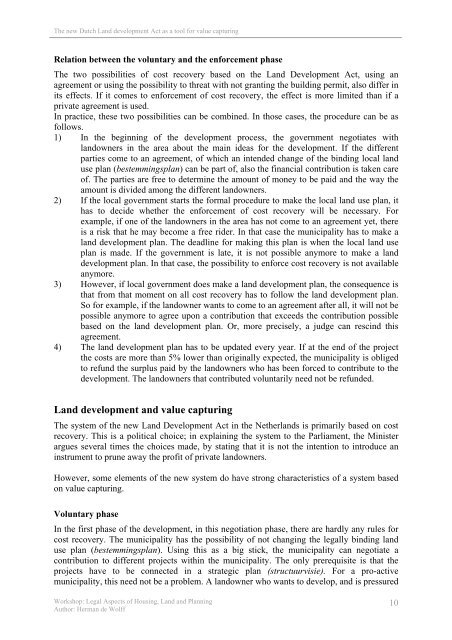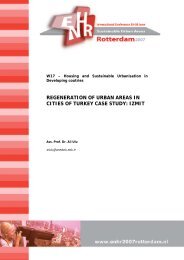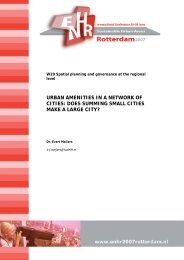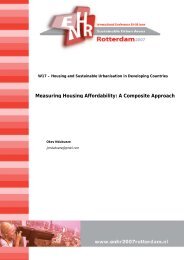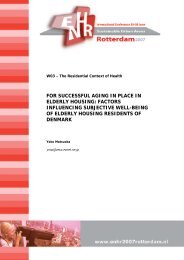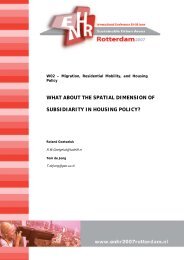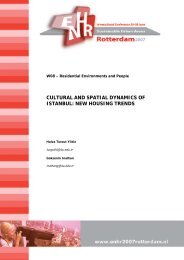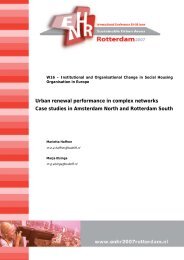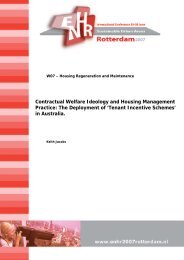The new Dutch Land development Act as a tool for value capturing
The new Dutch Land development Act as a tool for value capturing
The new Dutch Land development Act as a tool for value capturing
You also want an ePaper? Increase the reach of your titles
YUMPU automatically turns print PDFs into web optimized ePapers that Google loves.
<strong>The</strong> <strong>new</strong> <strong>Dutch</strong> <strong>Land</strong> <strong>development</strong> <strong>Act</strong> <strong>as</strong> a <strong>tool</strong> <strong>for</strong> <strong>value</strong> <strong>capturing</strong><br />
Relation between the voluntary and the en<strong>for</strong>cement ph<strong>as</strong>e<br />
<strong>The</strong> two possibilities of cost recovery b<strong>as</strong>ed on the <strong>Land</strong> Development <strong>Act</strong>, using an<br />
agreement or using the possibility to threat with not granting the building permit, also differ in<br />
its effects. If it comes to en<strong>for</strong>cement of cost recovery, the effect is more limited than if a<br />
private agreement is used.<br />
In practice, these two possibilities can be combined. In those c<strong>as</strong>es, the procedure can be <strong>as</strong><br />
follows.<br />
1) In the beginning of the <strong>development</strong> process, the government negotiates with<br />
landowners in the area about the main ide<strong>as</strong> <strong>for</strong> the <strong>development</strong>. If the different<br />
parties come to an agreement, of which an intended change of the binding local land<br />
use plan (bestemmingsplan) can be part of, also the financial contribution is taken care<br />
of. <strong>The</strong> parties are free to determine the amount of money to be paid and the way the<br />
amount is divided among the different landowners.<br />
2) If the local government starts the <strong>for</strong>mal procedure to make the local land use plan, it<br />
h<strong>as</strong> to decide whether the en<strong>for</strong>cement of cost recovery will be necessary. For<br />
example, if one of the landowners in the area h<strong>as</strong> not come to an agreement yet, there<br />
is a risk that he may become a free rider. In that c<strong>as</strong>e the municipality h<strong>as</strong> to make a<br />
land <strong>development</strong> plan. <strong>The</strong> deadline <strong>for</strong> making this plan is when the local land use<br />
plan is made. If the government is late, it is not possible anymore to make a land<br />
<strong>development</strong> plan. In that c<strong>as</strong>e, the possibility to en<strong>for</strong>ce cost recovery is not available<br />
anymore.<br />
3) However, if local government does make a land <strong>development</strong> plan, the consequence is<br />
that from that moment on all cost recovery h<strong>as</strong> to follow the land <strong>development</strong> plan.<br />
So <strong>for</strong> example, if the landowner wants to come to an agreement after all, it will not be<br />
possible anymore to agree upon a contribution that exceeds the contribution possible<br />
b<strong>as</strong>ed on the land <strong>development</strong> plan. Or, more precisely, a judge can rescind this<br />
agreement.<br />
4) <strong>The</strong> land <strong>development</strong> plan h<strong>as</strong> to be updated every year. If at the end of the project<br />
the costs are more than 5% lower than originally expected, the municipality is obliged<br />
to refund the surplus paid by the landowners who h<strong>as</strong> been <strong>for</strong>ced to contribute to the<br />
<strong>development</strong>. <strong>The</strong> landowners that contributed voluntarily need not be refunded.<br />
<strong>Land</strong> <strong>development</strong> and <strong>value</strong> <strong>capturing</strong><br />
<strong>The</strong> system of the <strong>new</strong> <strong>Land</strong> Development <strong>Act</strong> in the Netherlands is primarily b<strong>as</strong>ed on cost<br />
recovery. This is a political choice; in explaining the system to the Parliament, the Minister<br />
argues several times the choices made, by stating that it is not the intention to introduce an<br />
instrument to prune away the profit of private landowners.<br />
However, some elements of the <strong>new</strong> system do have strong characteristics of a system b<strong>as</strong>ed<br />
on <strong>value</strong> <strong>capturing</strong>.<br />
Voluntary ph<strong>as</strong>e<br />
In the first ph<strong>as</strong>e of the <strong>development</strong>, in this negotiation ph<strong>as</strong>e, there are hardly any rules <strong>for</strong><br />
cost recovery. <strong>The</strong> municipality h<strong>as</strong> the possibility of not changing the legally binding land<br />
use plan (bestemmingsplan). Using this <strong>as</strong> a big stick, the municipality can negotiate a<br />
contribution to different projects within the municipality. <strong>The</strong> only prerequisite is that the<br />
projects have to be connected in a strategic plan (structuurvisie). For a pro-active<br />
municipality, this need not be a problem. A landowner who wants to develop, and is pressured<br />
Workshop: Legal Aspects of Housing, <strong>Land</strong> and Planning<br />
Author: Herman de Wolff<br />
10


